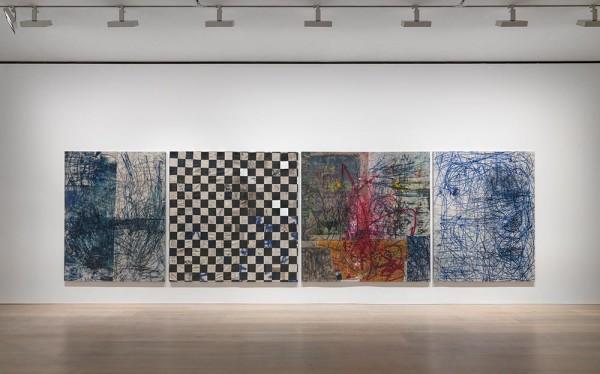David Zwirner is currently presenting Oscar Murillo’s first exhibition at the gallery in London, which includes new paintings and drawings as well as sculptural, sound, and film elements. The exhibition’s title, binary function, refers to the pairings that permeate Murillo’s multifaceted practice. For the artist, the notion of the binary is not oppositional; instead, these pairings work and play against one another to create a dialogue that exceeds individual works.
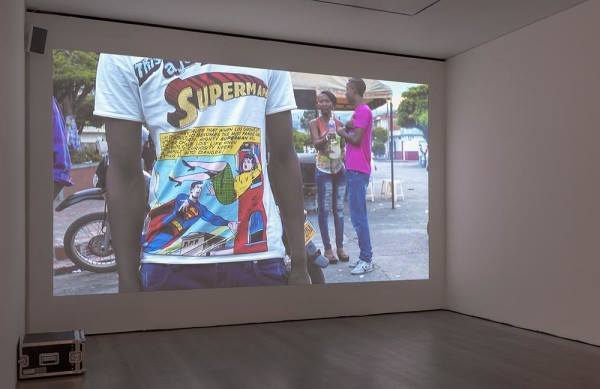 Image: Oscar Murillo, meet me! Mr. Superman, 2013-2015 Video projection, David Zwirner © Artlyst 2015.
Image: Oscar Murillo, meet me! Mr. Superman, 2013-2015 Video projection, David Zwirner © Artlyst 2015.
Binary function continues this thread of Murillo’s practice, in which conceptual dialogues manifest themselves through the artist’s engagement with materials. The exhibition includes a new video projection that depicts a street scene in Murillo’s hometown of La Paila, Colombia, in which people are seen chatting, drinking, and dancing to live music. Filmed by the artist on New Year’s Day, its footage shifts between documentary and experimental styles, using both wide-angle and detail shots that, at times, abstract the figures’ bodies into a chaotic arrangement of imagery, colour, and movement. Murillo employs sound as a major, integral component of the work: its soundtrack fades between the original audio and a commissioned score, interweaving loud, jarring street noise with tempered bell-like harmonies. The audio will be played throughout the exhibition space, creating an architecture of sound whose ambience acts as a transition between the depicted scene and the exhibition at large, and complements the physicality of the adjoining installations.
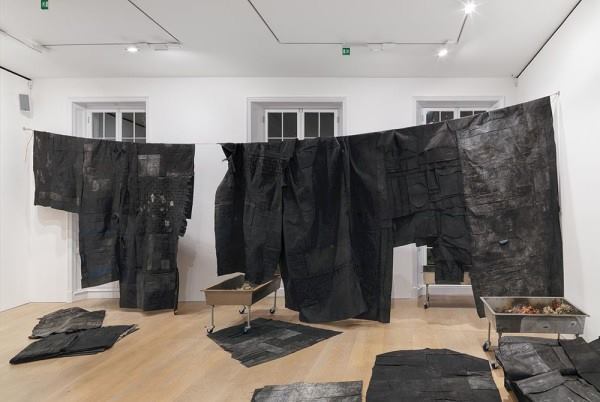 Image: Oscar Murillo, meandering – black wall, 2014-2015, Oil, dirt, corn, and clay on canvas and copper wire, David Zwirner © Artlyst 2015.
Image: Oscar Murillo, meandering – black wall, 2014-2015, Oil, dirt, corn, and clay on canvas and copper wire, David Zwirner © Artlyst 2015.
The large-scale, seemingly frenetic paintings, for which Murillo has become widely known, develop gradually and often incorporate materials that change and react over time, with canvases literally moved around his studio to accumulate sole imprints, fingerprints, and dust. Just as the material conditions of the studio in this way become inseparable from the finished artwork, Murillo invites viewers to approach their physical engagement with the gallery space as part of the viewing process. As such, they become implicated within the dual process of production and consumption.
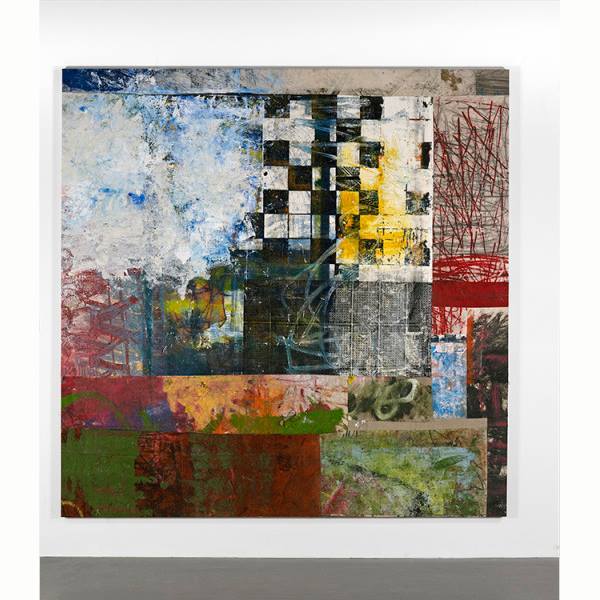 Image: Oscar Murillo, 100% vita, 2014-2015, Oil and oil stick on canvas and linen, David Zwirner © Artlyst 2015.
Image: Oscar Murillo, 100% vita, 2014-2015, Oil and oil stick on canvas and linen, David Zwirner © Artlyst 2015.
The exhibition continues a recent development within Murillo’s practice in which multimedia works are grouped together within clear plastic tray frames. Comprising wide-ranging imagery and materials, including small-scale drawings, screen prints, and the artist’s own travel photographs, these compositions vary in their degree of engagement with the processes of painting, drawing, screen printing, and installation. They can thus be seen as visual primers for the works in the show as well as Murillo’s own creative process; the artist regularly refers to his paintings in terms of drawing, and his studio practice at large integrates various forms of printmaking.
Material alignment, a new body of black-and-white grid paintings, can likewise be seen to present a visual analogy of the artist’s working methods with their oscillation between labor-intensive production and spontaneous improvisation. Individual squares, seemingly containing traces of larger compositions, are carefully stitched together, creating a tension between order and chaos that finds a physical component in the optical sensations triggered by the grid.
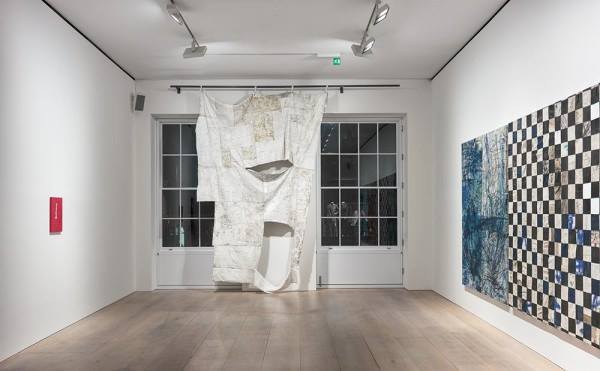 Image: Oscar Murillo, Binary Function, installation view, David Zwirner © Artlyst 2015.
Image: Oscar Murillo, Binary Function, installation view, David Zwirner © Artlyst 2015.
A major new installation in the upper galleries comprises large, heavily painted black canvases (made of several sewn-together fragments and reminiscent of leather hides) suspended across the gallery, piled on top of one another on steel pallets, and also strewn across tables. An adjacent canvas, one of a series of new figurative works in the exhibition, depicts a painting Murillo encountered in a collector’s home in Bogotá—showing a young boy selling fish—against Regency-style wallpaper and antique furniture. Murillo’s physical engagement with his materials has an anthropomorphic effect, which in turn contextualises the installation within the socio-political landscape of post-colonial Colombia. Intensified by the subtle smell of oil paint and the presence of decomposing corn sculptures, its corporeal and abject nature creates a thought-provoking viewing experience that aims to destabilise the codified conditions of display present within the initial painting.
 Image: Oscar Murillo, Binary Function, installation view, David Zwirner © Artlyst 2015.
Image: Oscar Murillo, Binary Function, installation view, David Zwirner © Artlyst 2015.
About the artist:
Oscar Murillo was born in 1986 in La Paila, Colombia. He lives and works in London, where he earned his B.F.A. in 2007 from the University of Westminster, followed by his M.F.A. in 2012 from the Royal College of Art. In 2013, the artist joined David Zwirner. His first gallery solo exhibition, titled A Mercantile Novel, was presented at David Zwirner, New York in 2014.
In November 2015, Murillo will present newly commissioned work for Performa 15 in New York. Entitled Lucky dip, a series of performances and installations will take place over the course of one week at the Alexander Hamilton U.S. Custom House, an important historical site in downtown Manhattan. An upcoming solo exhibition is planned for the spring of 2016 at the Yarat Contemporary Art Centre in Baku, Azerbaijan.
Oscar Murillo: Binary Function – David Zwirner London – until 20 November 2015
See Oscar Murillo in our Top Ten – Artists Under 30 here

